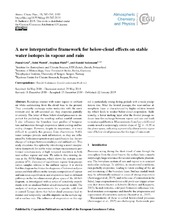| dc.contributor.author | Graf, Pascal | |
| dc.contributor.author | Wernli, Heini | |
| dc.contributor.author | Pfahl, Stephan | |
| dc.contributor.author | Sodemann, Harald | |
| dc.date.accessioned | 2020-04-17T09:49:40Z | |
| dc.date.available | 2020-04-17T09:49:40Z | |
| dc.date.issued | 2019-01-22 | |
| dc.Published | Graf P, Wernli H, Pfahl S, Sodemann H. A new interpretative framework for below-cloud effects on stable water isotopes in vapour and rain. Atmospheric Chemistry and Physics. 2019;19(2):747-765 | eng |
| dc.identifier.issn | 1680-7324 | en_US |
| dc.identifier.issn | 1680-7316 | en_US |
| dc.identifier.uri | https://hdl.handle.net/1956/21909 | |
| dc.description.abstract | Raindrops interact with water vapour in ambient air while sedimenting from the cloud base to the ground. They constantly exchange water molecules with the environment and, in sub-saturated air, they evaporate partially or entirely. The latter of these below-cloud processes is important for predicting the resulting surface rainfall amount. It also influences the boundary layer profiles of temperature and moisture through evaporative latent cooling and humidity changes. However, despite its importance, it is very difficult to quantify this process from observations. Stable water isotopes provide such information, as they are influenced by both rain evaporation and equilibration (i.e. the exchange of isotopes between raindrops and ambient air). This study elucidates this option by introducing a novel interpretative framework for stable water isotope measurements performed simultaneously at high temporal resolution in both near-surface vapour and rain. We refer to this viewing device as the ΔδΔd-diagram, which shows the isotopic composition (δ2H, d-excess) of equilibrium vapour from precipitation samples relative to the ambient vapour. It is shown that this diagram facilitates the diagnosis of below-cloud processes and their effects on the isotopic composition of vapour and rain since equilibration and evaporation lead to different pathways in the two-dimensional phase space of the ΔδΔd-diagram, as investigated with a series of sensitivity experiments with an idealized below-cloud interaction model. The analysis of isotope measurements for a specific cold front in central Europe shows that below-cloud processes lead to distinct and temporally variable imprints on the isotope signal in surface rain. The influence of evaporation on this signal is particularly strong during periods with a weak precipitation rate. After the frontal passage, the near-surface atmospheric layer is characterized by higher relative humidity, which leads to weaker below-cloud evaporation. Additionally, a lower melting layer after the frontal passage reduces time for exchange between vapour and rain and leads to weaker equilibration. Measurements from four cold frontal events reveal a surprisingly similar slope of ΔdΔδ=−0.30 in the phase space, indicating a potentially characteristic signature of below-cloud processes for this type of rain event. | en_US |
| dc.language.iso | eng | eng |
| dc.publisher | Copernicus Publications | en_US |
| dc.rights | Attribution CC BY | eng |
| dc.rights.uri | http://creativecommons.org/licenses/by/4.0/ | eng |
| dc.title | A new interpretative framework for below-cloud effects on stable water isotopes in vapour and rain | en_US |
| dc.type | Peer reviewed | |
| dc.type | Journal article | |
| dc.date.updated | 2019-12-20T14:14:58Z | |
| dc.description.version | publishedVersion | en_US |
| dc.rights.holder | Copyright 2019 The Author(s) | en_US |
| dc.identifier.doi | https://doi.org/10.5194/acp-19-747-2019 | |
| dc.identifier.cristin | 1694512 | |
| dc.source.journal | Atmospheric Chemistry and Physics | |
| dc.relation.project | Norges forskningsråd: 262710 | |
| dc.relation.project | Norges forskningsråd: 245907 | |

